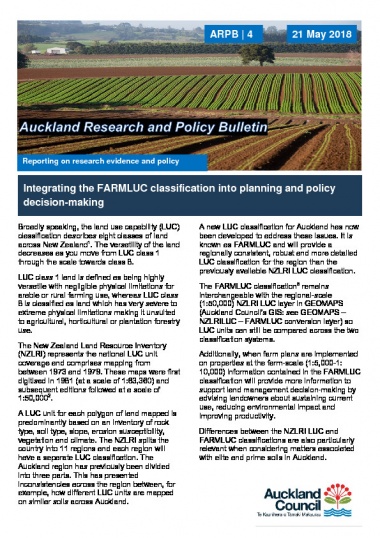Integrating the FARMLUC classification into planning and policy decision-making
Author:
Fiona Curran-CournaneSource:
Auckland Council Research and Evaluation Unit, RIMUPublication date:
2018Topics:
EnvironmentExtract
Broadly speaking, the land use capability (LUC) classification describes eight classes of land across New Zealand. The versatility of the land decreases as you move from LUC class 1 through the scale towards class 8.
LUC class 1 land is defined as being highly versatile with negligible physical limitations for arable or rural farming use, whereas LUC class 8 is classified as land which has very severe to extreme physical limitations making it unsuited to agricultural, horticultural or plantation forestry use.
The New Zealand Land Resource Inventory (NZLRI) represents the national LUC unit coverage and comprises mapping from between 1973 and 1979. These maps were first digitised in 1981 (at a scale of 1:63,360) and subsequent editions followed at a scale of 1:50,000.
A LUC unit for each polygon of land mapped is predominantly based on an inventory of rock type, soil type, slope, erosion susceptibility, vegetation and climate. The NZLRI splits the country into 11 regions and each region will have a separate LUC classification. The Auckland region has previously been divided into three parts. This has presented inconsistencies across the region between, for example, how different LUC units are mapped on similar soils across Auckland.
A new LUC classification for Auckland has now been developed to address these issues. It is known as FARMLUC and will provide a regionally consistent, robust and more detailed LUC classification for the region than the previously available NZLRI LUC classification.
The FARMLUC classification3 remains interchangeable with the regional-scale (1:50,000) NZLRI LUC layer in GEOMAPS (Auckland Council’s GIS: see GEOMAPS – NZLRILUC – FARMLUC conversion layer) so LUC units can still be compared across the two classification systems.
Additionally, when farm plans are implemented on properties at the farm-scale (1:5,000-1: 10,000) information contained in the FARMLUC classification will provide more information to support land management decision-making by advising landowners about sustaining current use, reducing environmental impact and improving productivity.
Differences between the NZLRI LUC and FARMLUC classifications are also particularly relevant when considering matters associated with elite and prime soils in Auckland. ...
Auckland Council, May 2018.
See also
Farm-scale land use capability classification for Auckland
Matching farm production data to land use capability for Auckland
